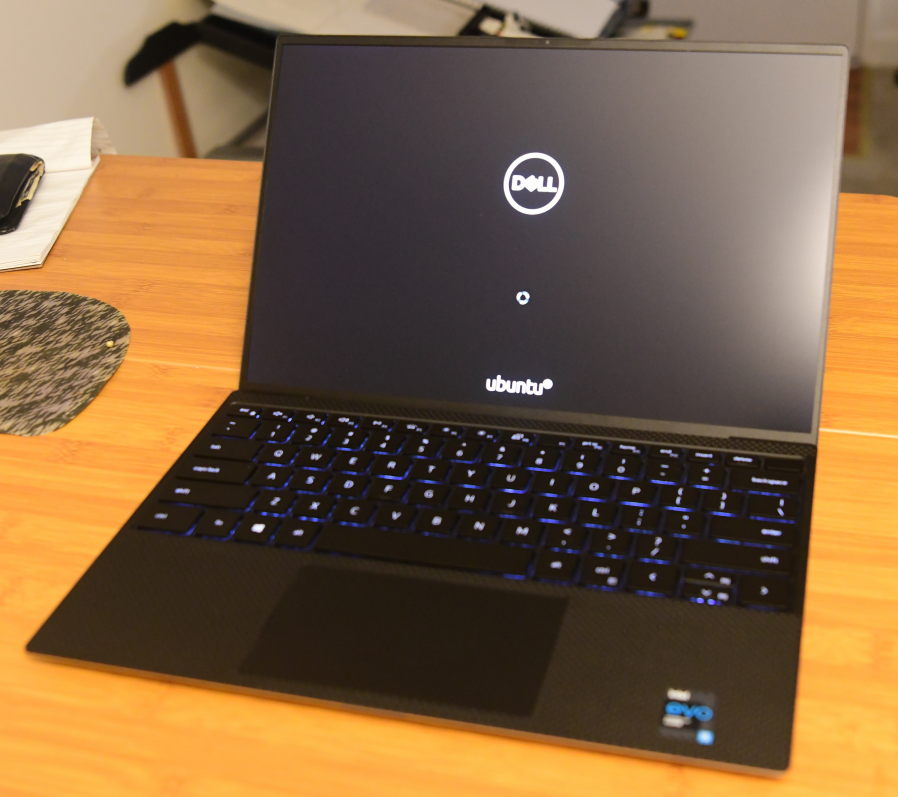93
Linux on the Dell XPS 13 (9310) Developer Edition
Linux on the Dell XPS 13 (9310) Developer Edition

Laptop ordered Oct 2, arrived Oct 14. The reviews on this laptop were good,
including that this time it comes with Ubuntu 20.04 pre-installed, and it's using
USB-C for power now (this would have been a dealbreaker for me).
I opted for the somewhat cheaper 11th Gen i5 (Tiger Lake) and since memory is soldered,
I maxed that at 16GB. Opted for the midrange 512GB NVME SSD. Runs at a base freq of 2.4GHz (4838 bogomips),
but the speed on laptops really depends on the power saving settings. Turbo speed is 4.2GHz.
This is a developers edition, so to get that you will need to tune it yourself. But it's a UP3
(TDP is from 12-28W), not the slower performing UP4. The corresponding i7 version should be able 12%
faster, judging from the burst peak frequency.
Here are the specs:
11th Generation Intel(R) Core(TM) i5-1135G7 Processor (8MB Cache, up to 4.2 GHz)
16GB 4267MHz LPDDR4x Memory (Soldered Onboard)
4-Cell, 52 WHr, Integrated battery (cannot be replaced by user)
45W USB-C AC Adapter Black
Intel(R) Iris Xe Graphics
512GB M.2 PCIe NVMe Solid State Drive
13.4inch FHD+ (1920 x 1200) InfinityEdge Non-Touch Anti-Glare 500-Nit Display
Black Backlit English Keyboard with Fingerprint Reader
Killer(TM) Wi-Fi 6 AX1650 (2x2) and Bluetooth 5.1
Their Ubuntu 20.04 installed quickly, it was under a minute. It saw my network printer right away,
I made connection accounts to Google and UbuntuOne, and enabled LivePatch.
Three partitions:
EFI (790MB), Recovery (8GB) and Root (768GB). Swap was set up as 2GB in a swapfile.
Disk I/O speed was about 2000 MB/s (hdparm) in power mode.
The only other peripheral it came with was a USB-C to USB-A flat converter cable.
Good for external mouse I guess. The powerbutton (top right of keyboard) looks like a key, and also doubles as
a fingerprint reader. I haven't found the app to use it (neither do I have a desire)
Good, Bad and Ugly impressions:
- +: running a very recent kernel (5.6.0-1031) which supports Thunderbolt-4. Compared to the stock 5.4.0
Ubuntu 12.04 LTS.
- +: very very bright (500 Nits) screen. I keep it on a very low level. But should be good for outdoors.
- +: two USB-C ports, one on each side. Why doesn't everybody do this?
- ?: the USB-C ports are actually Thunderbolt-4, but don't have anything to test.
- -: two USB-C ports. You need to get a USB-C hub to do anything.
OK, there is a micro-SD slot on the left, and a 3.5mm audio jack on the right.
- -: compared to my normal Lenovo, the Fn-Ctrl is now Ctrl-Fn on the lower left of keyboard.
I could be remapped.
- -: it did not come with a screen-keyboard protector. I'm kind of used to this from Lenovo.
- -: the screen does not fold flat. Maybe 150 degrees or so. The hinges are in the way.
It also does not keep the angle as well as the Lenovos, those are more stiff.
- -: as installed, I could not get Geekbench5 to go over about 1050 in single core mode. After installing TLP and using
sudo tlp ac
I could force it to the higher
level I had expected: about 1470. In the mean time I also installed a shell extension from which one can
also pick the powerlevel. The cpufreq command also had to be installed for some finegrained settings. In short: DELL didn't give users tools to tune performance. But hey, it's a developers edition
- -: had a few mysterious "lockups", where mouse focus stopped working (but I could resize a window).
no input possible. could not kill. etc. solution was to reboot. bit worrysome.
- -: the wifi on a WiFi6 network is not steady and under-performing. An older(?) Wireless-AC 9462 on my X1Y4 performs much better
- -: the command lspci is not as informative as on other laptops I have
- -: When you type your password in Gnome3 after the screen locked, there is
a noticably longer delay than in KDE.
- -: every now and then GnomeShell is going nuts, CPU hogging and slowing down everything interactive. A restart is needed. E.g. ALT-F2 'r', or 'gnome-shell --replace', seems to solve it.
- -: doesn't always properly suspend, and runs the battery down.
- -: has locked up fairly regularly.
-
These days I'm a KDE user, but I thought this would be a good excuse to re-force Gnome3 on me. Here's
the tinkering I started out with (more to come no doubt):
- In KDE installing widgets (as they call it) is a simple one step process. In Gnome they are called
shell extensions. I wrote about that process
here and I find
it laborious, and also needs Firefox to manage the extensions. Both have their issues though, none is perfect.
- Installed the usual compilers and tools. Dell's ubuntu came with "only" 1745 packages
installed. On my kubuntu system I have a little over 3000 now after X months.
Other references (google might give you more by now)
This page was last modified on
07-Mar-2021
by teuben@astro.umd.edu.
